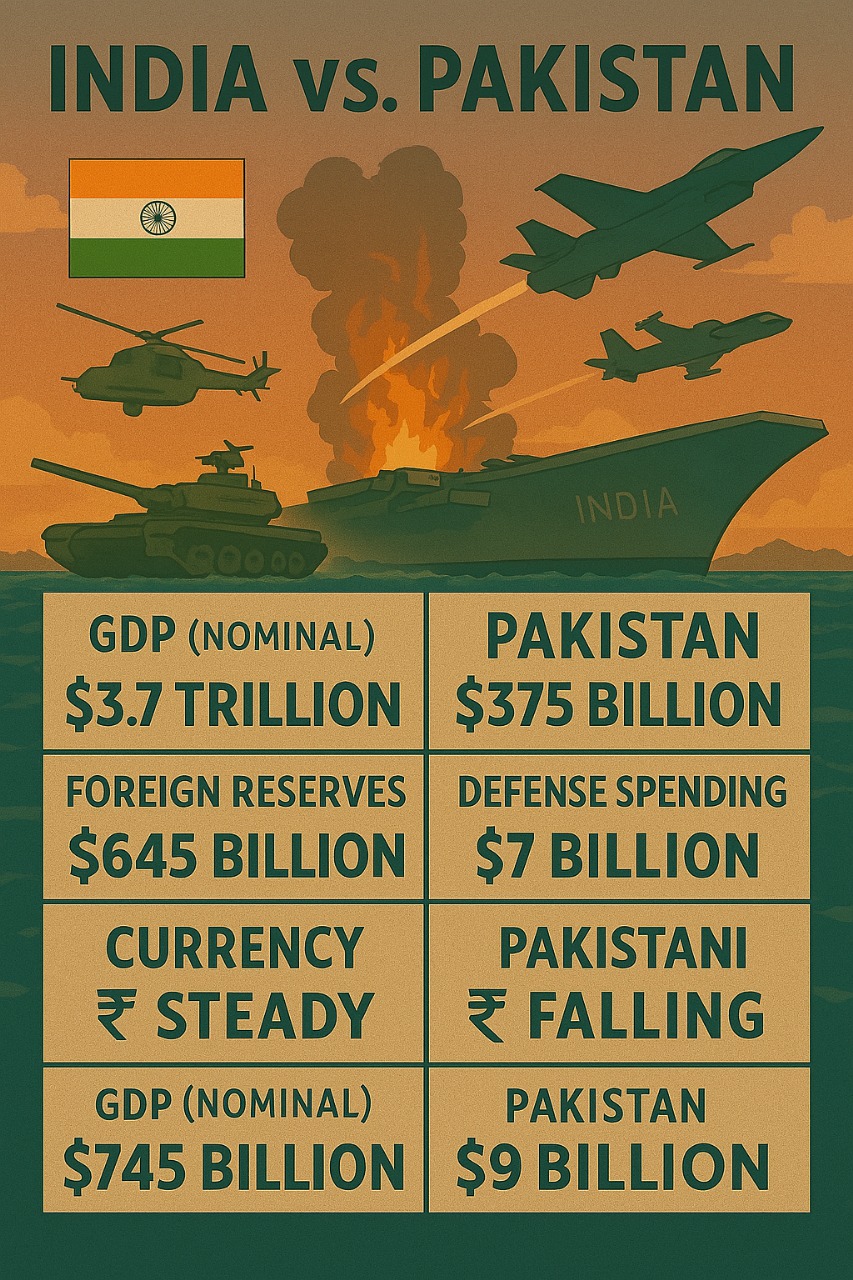The recent escalation in tensions between India and Pakistan has reignited concerns over the potential economic consequences of military conflict in South Asia. While both nations would undoubtedly suffer in the event of a full-scale war, analyses suggest that Pakistan’s economy is significantly more vulnerable to the shocks of such aggression compared to India’s. This article delves into the economic structures of both countries, examining why Pakistan stands to face more severe repercussions.
Economic Overview: India vs. Pakistan
India’s Economic Resilience
- GDP and Growth: India boasts a GDP of approximately $3.7 trillion, making it the world’s fifth-largest economy. Its diversified economy spans agriculture, manufacturing, and services, contributing to steady growth rates averaging 6-7% annually.
- Foreign Exchange Reserves: India’s foreign exchange reserves exceed $600 billion, providing a substantial buffer against external shocks.
- Debt Management: With a debt-to-GDP ratio around 85%, India maintains a manageable debt profile, supported by strong domestic savings and investment rates.
Pakistan’s Economic Fragility
- GDP and Growth: Pakistan’s GDP stands at approximately $350 billion, with growth rates fluctuating due to political instability and structural issues.
- Foreign Exchange Reserves: Reserves have dwindled to around $9 billion, barely covering two months of imports, raising concerns over balance of payments crises.Financial Times
- Debt Burden: External debt has surpassed $131 billion, with significant portions owed to international financial institutions and bilateral creditors.
Impact of Military Conflict on Economies
Historical Precedents
- Kargil War (1999): India’s markets experienced a brief downturn but rebounded quickly due to strong economic fundamentals. Pakistan, however, faced prolonged economic sanctions and aid suspensions, exacerbating fiscal deficits.
- Balakot Airstrikes (2019): India’s economy remained largely unaffected, while Pakistan saw a depreciation of its currency and a decline in investor confidence.
Current Tensions and Market Reactions
- India: Recent skirmishes led to a temporary dip in stock markets and a slight depreciation of the rupee. However, the overall economic outlook remains stable, with foreign investors maintaining confidence.
- Pakistan: The economy has shown signs of distress, with the Pakistani rupee under pressure and stock markets experiencing volatility. The potential for sanctions and reduced foreign aid looms large.
Structural Vulnerabilities
Pakistan’s Dependence on External Aid
Pakistan’s economy heavily relies on financial assistance from the International Monetary Fund (IMF), World Bank, and friendly nations. Military conflict risks derailing ongoing negotiations and disbursements, leading to liquidity crises.Financial Times
India’s Diversified Economy
India’s broad economic base, encompassing IT services, pharmaceuticals, and a burgeoning manufacturing sector, provides resilience against sector-specific shocks. This diversification aids in absorbing the impacts of geopolitical tensions.
Defense Expenditure and Fiscal Implications
India’s Strategic Spending
India allocates approximately 2.4% of its GDP to defense, focusing on modernization and indigenous production. The fiscal impact is mitigated by a robust tax base and economic growth.
Pakistan’s Military Spending
Pakistan spends about 4% of its GDP on defense, a significant burden given its limited fiscal space. Increased military expenditure during conflicts strains public finances, often at the expense of social and development programs.
International Relations and Economic Consequences
India’s Global Partnerships
India’s strategic alliances with major economies, including the United States, European Union, and Japan, provide economic and diplomatic support during crises. These relationships can help cushion the blow of international sanctions or trade disruptions.
Pakistan’s Diplomatic Challenges
Pakistan’s international relations are more limited, with heavy reliance on China and Gulf countries. Military aggression can jeopardize these ties, leading to reduced financial assistance and investment.
Conclusion
While any military conflict between India and Pakistan would have dire consequences, the economic impact would be disproportionately severe for Pakistan. Structural weaknesses, dependence on external aid, and limited fiscal capacity make Pakistan’s economy particularly susceptible to the shocks of aggression. In contrast, India’s diversified economy, substantial reserves, and global partnerships provide a buffer against such disturbances. As tensions persist, it is imperative for both nations to prioritize diplomatic solutions to avoid catastrophic economic fallout.
Note: This article is based on current economic data and historical analyses. The situation is fluid, and developments may alter the economic dynamics discussed.
❓ Trending Questions
- How would a military conflict impact Pakistan’s economy?
- A conflict could exacerbate Pakistan’s fiscal deficits, deplete foreign reserves, and deter foreign investment.
- A conflict could exacerbate Pakistan’s fiscal deficits, deplete foreign reserves, and deter foreign investment.
- Why is Pakistan’s economy considered more vulnerable than India’s?
- Due to lower GDP, limited foreign reserves, and higher dependency on external aid.
- Due to lower GDP, limited foreign reserves, and higher dependency on external aid.
- What role does the IMF play in Pakistan’s economy?
- The IMF provides financial assistance to stabilize Pakistan’s economy, which could be jeopardized during conflicts.The Indian Express Wikipedia
- The IMF provides financial assistance to stabilize Pakistan’s economy, which could be jeopardized during conflicts.The Indian Express Wikipedia
- How does defense spending affect Pakistan’s economic stability?
- High defense spending diverts funds from essential sectors, impacting overall economic growth.
- High defense spending diverts funds from essential sectors, impacting overall economic growth.
- What are the potential effects on Pakistan’s currency during a conflict?
- The Pakistani rupee may depreciate due to increased economic uncertainty and reduced investor confidence.
- The Pakistani rupee may depreciate due to increased economic uncertainty and reduced investor confidence.
- How might international investors react to a conflict involving Pakistan?
- Investors may withdraw capital, leading to stock market declines and reduced foreign direct investment.
- Investors may withdraw capital, leading to stock market declines and reduced foreign direct investment.
- Could a conflict disrupt Pakistan’s trade relations?
- Yes, especially if trade routes are compromised or sanctions are imposed.
- Yes, especially if trade routes are compromised or sanctions are imposed.
- What impact would a conflict have on Pakistan’s inflation rates?
- Inflation could rise due to supply chain disruptions and increased import costs.
- Inflation could rise due to supply chain disruptions and increased import costs.
- How does India’s economic resilience compare to Pakistan’s in conflict scenarios?
- India’s diversified economy and substantial reserves provide a buffer against economic shocks.
- India’s diversified economy and substantial reserves provide a buffer against economic shocks.
- What sectors in Pakistan would be most affected economically by a conflict?
- Manufacturing, agriculture, and services sectors could face significant disruptions.
- Manufacturing, agriculture, and services sectors could face significant disruptions.
- How might a conflict influence Pakistan’s unemployment rates?
- Job losses could occur due to business closures and reduced economic activity.
- Job losses could occur due to business closures and reduced economic activity.
- Would international aid to Pakistan continue during a conflict?
- Aid could be reduced or suspended, depending on the geopolitical stance of donor countries.
- Aid could be reduced or suspended, depending on the geopolitical stance of donor countries.
- How does public sentiment in Pakistan influence economic stability during tensions?
- Public unrest can lead to decreased consumer spending and hinder economic performance.
- Public unrest can lead to decreased consumer spending and hinder economic performance.
- What measures can Pakistan take to mitigate economic risks during conflicts?
- Implementing fiscal reforms, diversifying the economy, and seeking diplomatic resolutions.
- Implementing fiscal reforms, diversifying the economy, and seeking diplomatic resolutions.
- How does the global community view the economic risks of an India-Pakistan conflict?
- Global markets may react negatively, and international bodies often advocate for peaceful resolutions to avoid economic instability.









+ There are no comments
Add yours